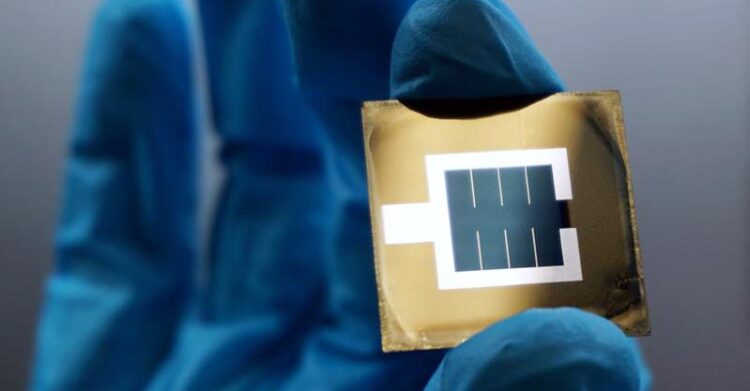World record: Tandem solar cell achieves 32.5 percent efficiency

Photo of the perovskite/silicon tandem solar cell. You can see the active bluish area in the middle of the wafer, which is enclosed by the metallic, silvery electrode.
Credit: Johannes Beckedahl/Lea Zimmerman/HZB
Scientists from HZB could significantly improve on the efficiency of perovskite/silicon tandem solar cells. “This is a really big leap forward that we didn’t foresee a few months ago. All the teams involved at HZB, especially the PV Competence Center (PVComB) and the HySPRINT Innovation lab teams have worked together successfully and with passion,” says Prof. Steve Albrecht.
Interface modifications
His team used an advanced perovskite composition with a very smart interface modification. The lead authors, postdocs Dr. Silvia Mariotti, and Dr. Eike Köhnen in Albrecht’s team, developed an interface modification to reduce charge carrier recombination losses and applied detailed analysis to understand the specific properties of the interface modification. These developments were then successfully implemented in tandem solar cells, and with help of Master’s student Lea Zimmermann, combined with further optical improvements.
In addition, many more scientists and technicians helped to develop and fabricate the tandem cells to achieve this success. Altogether, the interface and optical modifications enabled highest photovoltages (open-circuit voltage) and resulted in the new record efficiency for this fascinating tandem technology.
Fast progress
There is an ongoing efficiency development by various research institutes and companies over the last years and especially the last month were quite exciting for the field: Various teams from HZB had achieved a record value in late 2021 with an efficiency of 29.8% that was realized by periodic nanotextures. More recently, in summer 2022, the Ecole Polytechnique Fédérale de Lausanne, Switzerland, first reported a certified tandem cell above the 30% barrier at 31.3%, which is a remarkable efficiency jump over the 2021 value.
With the new certified value of 32.5%, the record is again back at HZB. “We are very excited about the new value as it shows that the perovskite/silicon tandem technology is highly promising for contributing to a sustainable energy supply,” says Albrecht.
HZB’s scientific director, Prof. Bernd Rech, emphasises: “At 32.5 percent, the solar cell efficiency of the HZB tandems is now in ranges previously only achieved by expensive III/V semiconductors. The NREL graph clearly shows how spectacular the last two increases from EPFL and HZB really are.”
Media Contact
Antonia Roetger
Helmholtz-Zentrum Berlin für Materialien und Energie
antonia.roetger@helmholtz-berlin.de
Office: 0049-308-062-43733
Media Contact
All latest news from the category: Power and Electrical Engineering
This topic covers issues related to energy generation, conversion, transportation and consumption and how the industry is addressing the challenge of energy efficiency in general.
innovations-report provides in-depth and informative reports and articles on subjects ranging from wind energy, fuel cell technology, solar energy, geothermal energy, petroleum, gas, nuclear engineering, alternative energy and energy efficiency to fusion, hydrogen and superconductor technologies.
Newest articles

First-of-its-kind study uses remote sensing to monitor plastic debris in rivers and lakes
Remote sensing creates a cost-effective solution to monitoring plastic pollution. A first-of-its-kind study from researchers at the University of Minnesota Twin Cities shows how remote sensing can help monitor and…

Laser-based artificial neuron mimics nerve cell functions at lightning speed
With a processing speed a billion times faster than nature, chip-based laser neuron could help advance AI tasks such as pattern recognition and sequence prediction. Researchers have developed a laser-based…

Optimising the processing of plastic waste
Just one look in the yellow bin reveals a colourful jumble of different types of plastic. However, the purer and more uniform plastic waste is, the easier it is to…



